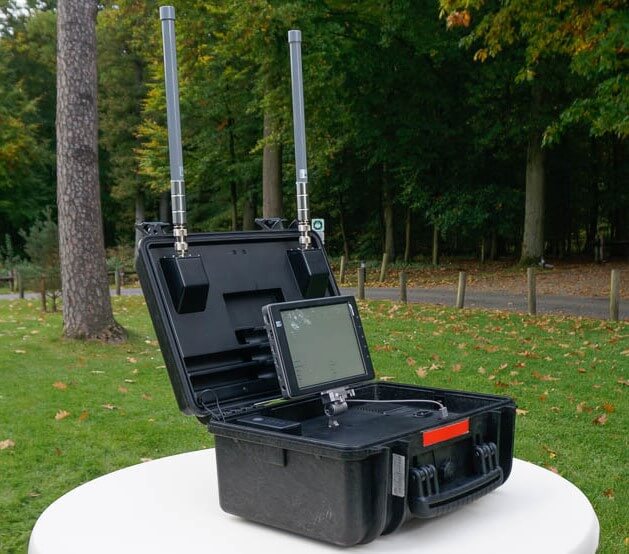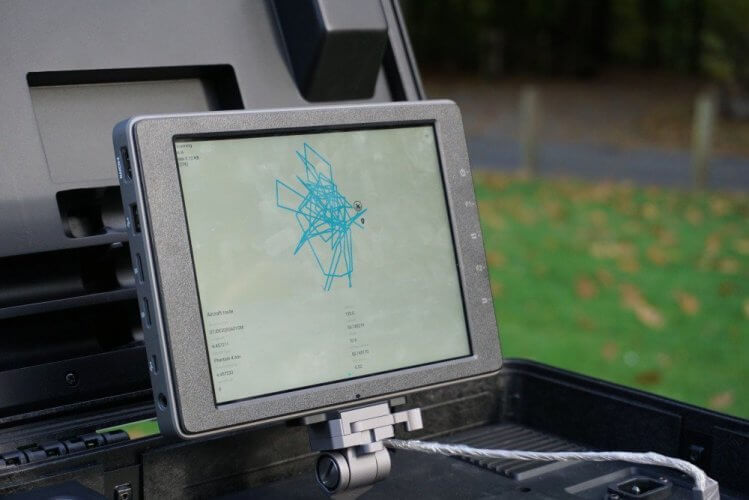
In the face of serious opposition arising from the growing number of drone scares, DJI have unveiled their latest step forward in the drone world - AeroScope. AeroScope is a cutting edge DJI drone detection and identification system which is available for authorised bodies, such as local police and aviation authorities.
Why do we need AeroScope?
Now, you may be wondering why the largest drone manufacturer in the world would release a drone regulation system. Admittedly, it does seem odd at first glance, but it truly encapsulates DJI's problem solving attitude and, in my opinion, it's a genius move. The global attitude towards drones and drone users has become increasingly toxic with each passing incident. From near misses at airports, to a general suspicion and assumption of privacy invasion - there is no denying that society is turning against drones. In the United States alone, the FAA had 1274 possible drone sighting reports from pilots from February through to September 2016, a huge increase of 45.77% from the same period in 2015. Whilst you may be wondering how dangerous these drones can actually be, consider that according to DJI, the Phantom 4 Pro can fly up to a height of about 19,000 feet - it's certainly not a toy. As Steve Landells, a flight safety expert from BALPA explains, a drone is unlikely to bring down a plane, but if it goes into an engine, BALPA expect that engine to stop. Whilst planes are designed to fly with an engine out, and pilots are trained for every eventuality - a drone collision reduces safety margins and, therefore, should be avoided at all costs. Through the introduction of AeroScope, it seems that DJI are aiming to curb society's drone-phobia, which would certainly be a huge breakthrough for them. Anyway, enough on my opinion - lets get right in to
what it actually is.
AeroScope Explained
AeroScope is a brand new system from Chinese drone manufacturer DJI. It is capable of detecting and identifying DJI drones within a 5km radius. It works on all current DJI models, and requires no software updates or hardware adjustments - plus, it's ready to be rolled out immediately. Sceptics may be feeling a little short changed, considering that this new system only works for DJI craft; however, DJI analysts have said that they control "over two-thirds of the global civilian drone market". This figure even includes nano drones and tiny whoops, some of which don't even have the ability to fly outside - meaning that if you spot a drone above you, it's probably made by DJI.

Now, "detection and identification system" seems like some spiel that a group of highly paid employees in a corner office made up, to sound increasingly ambiguous - so lets get into some more detail. When AeroScope detects a drone within its 5km radius, it can draw full telemetry readings (location, speed, altitude and direction) from the drone, and will even plot the crafts location onto google maps for you. Some of you innocent drone users out there may feel that this system is a little intrusive, why should your drone be identified if you're simply flying around on your land? Well, in DJI's press release, they have said that "In an effort to protect the privacy of drone operators, AeroScope will not automatically transmit any personally identifiable information until the time when regulations in a pilot’s jurisdiction require it by law". Allow me to translate yet more marketing spiel - because there is not currently any legislation compelling pilots to allow their drones to be remotely identified, users can currently restrict what personal information can be accessed by AeroScope - such as their name and their email. However, if, and when, a regulatory mandate is introduced, these user options will be removed so that any information that is required by law to be transmitted, is transmitted.
So, how does it work?
AeroScope essentially works by tapping in to the communications between the controller and the craft, and decoding them; therefore, allowing the system to receive real-time telemetry from the craft. Furthermore, this method should provide more peace of mind for drone pilots, as it means that no flight records, or telemetry information can be automatically recorded onto a database - as the communication still happens on through the radio signal, and not through satellite. This technique also means that drones can also not be detected, tracked or identified unless they are turned on, and connected to a controller.
AeroScope - a Saviour, Not a Threat
![Regulation Infographic]()
According to research firm Gartner, 3 million personal and commercial drones will be produced in 2017, nearly 40 percent more than in 2016, if that's not enough, the FAA (American version of the CAA) predicts that combined personal and commercial drone sales will reach 7 million by 2020. So, although as a drone user, AeroScope may not be an exciting or happy prospect - I believe that it is a necessary step to ensure the longevity of the drone world. Steps needed to be taken, and this system is consistent with DJI’s problem-solving attitude. They have struck a fair balance between authorities’ need to identify drones that raise concerns and drone pilots’ right to fly without pervasive surveillance. Far too often are the views of society soured, by the few, due to poor regulation. This system doesn't seek to end drone flying, nor does it want to scare drone users - it is made to combat drone misuse and, frankly, if you're misusing your drone, you should be prosecuted. Don't get caught out - make sure you're up to date on your drone laws by checking out Phil's blog on
The Latest UK Drone Rules and Regulations.
 In the face of serious opposition arising from the growing number of drone scares, DJI have unveiled their latest step forward in the drone world - AeroScope. AeroScope is a cutting edge DJI drone detection and identification system which is available for authorised bodies, such as local police and aviation authorities.
In the face of serious opposition arising from the growing number of drone scares, DJI have unveiled their latest step forward in the drone world - AeroScope. AeroScope is a cutting edge DJI drone detection and identification system which is available for authorised bodies, such as local police and aviation authorities.
 Now, "detection and identification system" seems like some spiel that a group of highly paid employees in a corner office made up, to sound increasingly ambiguous - so lets get into some more detail. When AeroScope detects a drone within its 5km radius, it can draw full telemetry readings (location, speed, altitude and direction) from the drone, and will even plot the crafts location onto google maps for you. Some of you innocent drone users out there may feel that this system is a little intrusive, why should your drone be identified if you're simply flying around on your land? Well, in DJI's press release, they have said that "In an effort to protect the privacy of drone operators, AeroScope will not automatically transmit any personally identifiable information until the time when regulations in a pilot’s jurisdiction require it by law". Allow me to translate yet more marketing spiel - because there is not currently any legislation compelling pilots to allow their drones to be remotely identified, users can currently restrict what personal information can be accessed by AeroScope - such as their name and their email. However, if, and when, a regulatory mandate is introduced, these user options will be removed so that any information that is required by law to be transmitted, is transmitted.
Now, "detection and identification system" seems like some spiel that a group of highly paid employees in a corner office made up, to sound increasingly ambiguous - so lets get into some more detail. When AeroScope detects a drone within its 5km radius, it can draw full telemetry readings (location, speed, altitude and direction) from the drone, and will even plot the crafts location onto google maps for you. Some of you innocent drone users out there may feel that this system is a little intrusive, why should your drone be identified if you're simply flying around on your land? Well, in DJI's press release, they have said that "In an effort to protect the privacy of drone operators, AeroScope will not automatically transmit any personally identifiable information until the time when regulations in a pilot’s jurisdiction require it by law". Allow me to translate yet more marketing spiel - because there is not currently any legislation compelling pilots to allow their drones to be remotely identified, users can currently restrict what personal information can be accessed by AeroScope - such as their name and their email. However, if, and when, a regulatory mandate is introduced, these user options will be removed so that any information that is required by law to be transmitted, is transmitted.
 According to research firm Gartner, 3 million personal and commercial drones will be produced in 2017, nearly 40 percent more than in 2016, if that's not enough, the FAA (American version of the CAA) predicts that combined personal and commercial drone sales will reach 7 million by 2020. So, although as a drone user, AeroScope may not be an exciting or happy prospect - I believe that it is a necessary step to ensure the longevity of the drone world. Steps needed to be taken, and this system is consistent with DJI’s problem-solving attitude. They have struck a fair balance between authorities’ need to identify drones that raise concerns and drone pilots’ right to fly without pervasive surveillance. Far too often are the views of society soured, by the few, due to poor regulation. This system doesn't seek to end drone flying, nor does it want to scare drone users - it is made to combat drone misuse and, frankly, if you're misusing your drone, you should be prosecuted. Don't get caught out - make sure you're up to date on your drone laws by checking out Phil's blog on The Latest UK Drone Rules and Regulations.
According to research firm Gartner, 3 million personal and commercial drones will be produced in 2017, nearly 40 percent more than in 2016, if that's not enough, the FAA (American version of the CAA) predicts that combined personal and commercial drone sales will reach 7 million by 2020. So, although as a drone user, AeroScope may not be an exciting or happy prospect - I believe that it is a necessary step to ensure the longevity of the drone world. Steps needed to be taken, and this system is consistent with DJI’s problem-solving attitude. They have struck a fair balance between authorities’ need to identify drones that raise concerns and drone pilots’ right to fly without pervasive surveillance. Far too often are the views of society soured, by the few, due to poor regulation. This system doesn't seek to end drone flying, nor does it want to scare drone users - it is made to combat drone misuse and, frankly, if you're misusing your drone, you should be prosecuted. Don't get caught out - make sure you're up to date on your drone laws by checking out Phil's blog on The Latest UK Drone Rules and Regulations.







